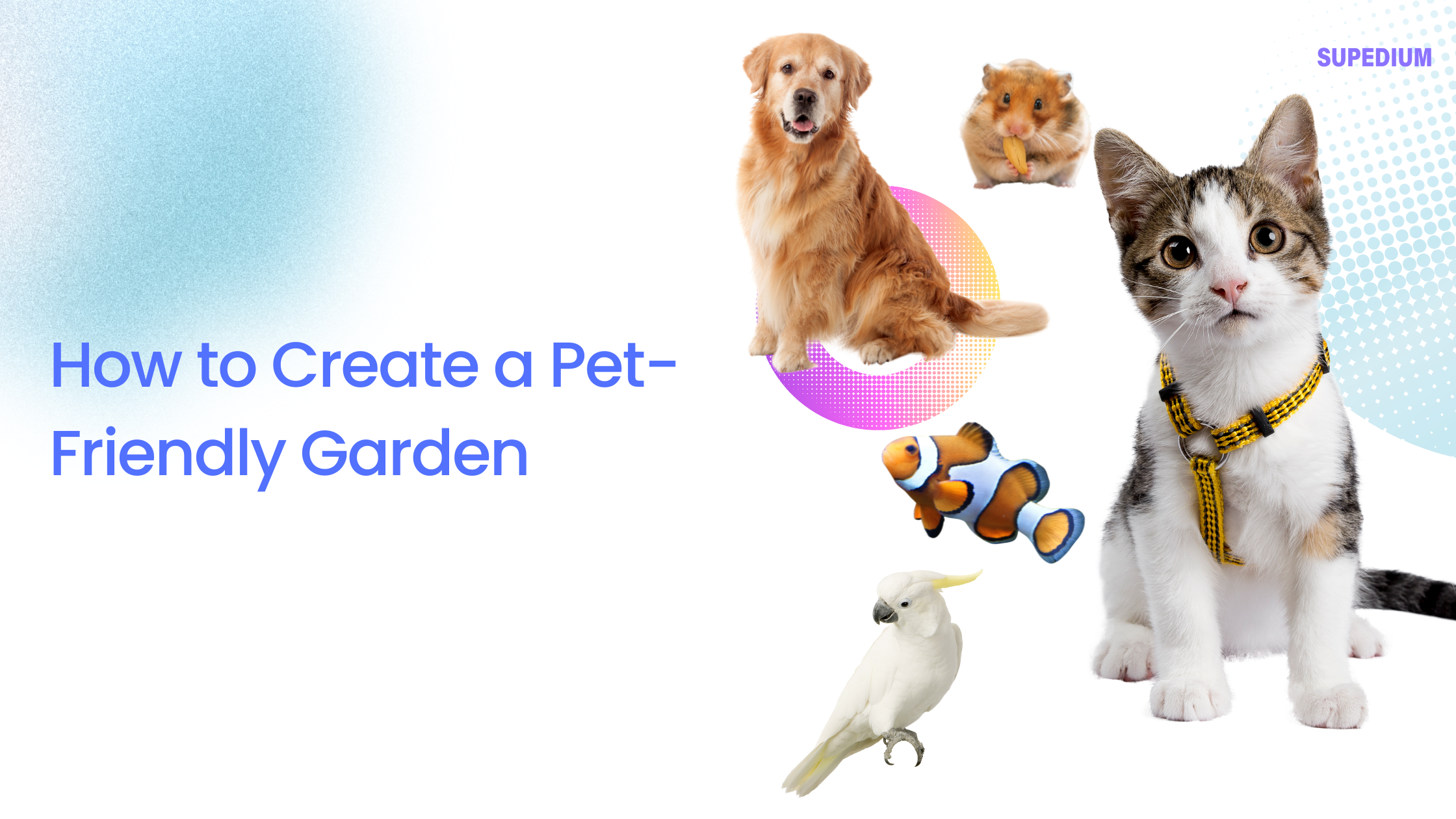Table of Contents
![]()
Creating a pet-friendly garden is more than just a design choice; it’s a commitment to ensuring that your outdoor space is safe, enjoyable, and enriching for your furry friends. Whether you have a playful puppy, a curious cat, or an adventurous rabbit, designing a garden that caters to their needs can enhance their well-being and make your garden a more harmonious place for everyone. This guide will walk you through the essentials of planning, designing, and maintaining a garden that your pets will love.
Planning Your Pet-Friendly Garden
Assessing Your Space and Pet’s Needs
Before diving into garden design, evaluate the size of your outdoor space and consider your pet’s specific needs. For instance, larger breeds might require more room to run and play, while smaller animals may benefit from more enclosed, cozy areas. Understanding your pet’s behavior—whether they enjoy digging, chewing, or lounging—will help you tailor the garden to their preferences.
Choosing the Right Plants
Pet-Safe Plants
Selecting non-toxic plants is crucial for creating a safe environment. Some pet-safe options include marigolds, sunflowers, and petunias. These plants add color and beauty to your garden without posing a risk to your pets. Conversely, avoid plants known to be toxic to animals, such as lilies, azaleas, and oleander, which can cause serious health issues if ingested.
Durability and Maintenance
In addition to being non-toxic, choose plants that can endure the wear and tear of pet activity. Hardy plants like lavender, sage, and certain types of grasses are resilient and can handle occasional rough play. Consider ground covers such as clover or thyme, which are not only durable but also provide a soft, comfortable surface for pets.
Garden Layout and Design
Designing Play Areas
Creating dedicated play zones can keep your pets active and entertained. Use durable ground covers like artificial turf or gravel to withstand the impact of running and digging. Adding agility equipment, such as tunnels or jumps, can provide physical and mental stimulation for energetic pets. Ensure that any play structures are securely anchored to prevent accidents.
Shelter and Rest Areas
Pets need comfortable spots to relax and escape the sun. Incorporate shaded areas or shelters using materials like wicker, wood, or specially designed pet houses. Outdoor pet beds or hammocks can offer a cozy resting place, while providing ample shade ensures your pet stays cool and comfortable.
Creating a Safe Environment
Fencing and Boundaries
Effective fencing is essential to keep pets contained and safe. Choose fencing materials that are appropriate for your pet’s size and jumping ability. For instance, taller, sturdy fences work well for large dogs, while smaller, secure enclosures are suitable for smaller animals. Ensure there are no gaps or weak spots where pets could escape.
Avoiding Harmful Chemicals and Materials
Pesticides and Fertilizers
Opt for organic or pet-safe pesticides and fertilizers to minimize the risk of poisoning. Regularly check and securely store any chemicals out of reach. Garden tools and equipment should also be kept in a safe place, as sharp or hazardous items could pose a danger to curious pets.
Pest Control
When dealing with pests, choose methods that won’t harm your pets. Natural repellents like neem oil or essential oils can be effective without posing risks. Regularly inspect your garden for pests and address issues promptly to maintain a safe environment.
Enhancing Pet Engagement
Interactive Features
Play Structures
Incorporating play structures like tunnels, climbing frames, or agility courses can keep your pets engaged and physically active. Ensure that these structures are made from durable materials and are securely installed. Regularly check for wear and tear to maintain safety.
Water Features
A pet-safe water feature can be a great addition, providing a place for pets to cool off and play. Shallow ponds or splash areas with clean, circulating water are ideal. Regular maintenance is essential to prevent algae build-up and ensure the water remains safe and clean.
Sensory Stimuli
Textures and Scents
Introduce a variety of textures to stimulate your pet’s senses. For example, mix grass with sand or mulch to create different surfaces for exploration. Planting aromatic herbs like mint or rosemary can add pleasant scents to the garden, offering additional sensory experiences for your pets.
Toys and Enrichment
Provide a range of toys and enrichment items to keep your pets mentally stimulated. Treat-dispensing toys, chew items, and interactive puzzles can offer hours of entertainment. Regularly rotate these items to maintain your pet’s interest and engagement.
Maintenance and Upkeep
Regular Cleaning
Keeping your garden clean is vital for both your pets’ health and the garden’s overall condition. Promptly clean up pet waste and dispose of it properly. Regularly remove debris and check for any hazardous objects that could harm your pets.
Seasonal Considerations
Adapting your garden care routine to the seasons can enhance its functionality and safety. In winter, protect plants from frost and ensure that pets have access to warm, dry areas. During summer, provide ample shade and water sources to keep pets cool and hydrated.
Troubleshooting Common Issues
Dealing with Digging and Chewing
If your pet is prone to digging or chewing, consider creating a designated digging area with sand or soil. Training and redirection can also help manage these behaviors. Providing appropriate chew toys and ensuring your garden is enriched with engaging activities can reduce the likelihood of destructive behavior.
Handling Allergies and Sensitivities
Some pets may have allergies or sensitivities to certain plants or materials. Observe your pet for any signs of discomfort and choose hypoallergenic plants and materials where possible. Consult with your veterinarian if you suspect allergies or other health concerns.
Conclusion
Creating a pet-friendly garden involves thoughtful planning and design to ensure that your outdoor space is safe, enjoyable, and stimulating for your pets. By selecting appropriate plants, incorporating interactive features, and maintaining a clean and secure environment, you can create a garden that both you and your pets will love. Adapt these ideas to fit your specific space and pets, and enjoy the rewards of a garden that enhances the well-being and happiness of your furry companions.
Share This





Be the first to comment